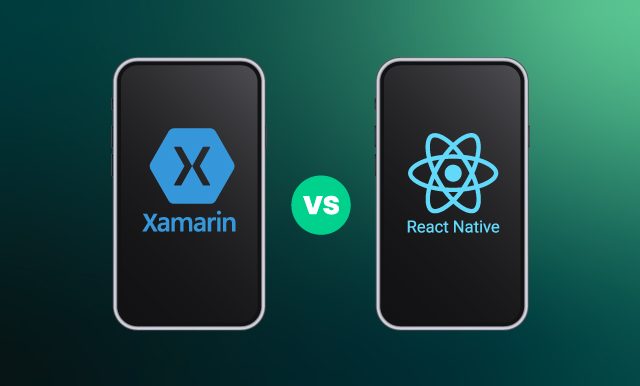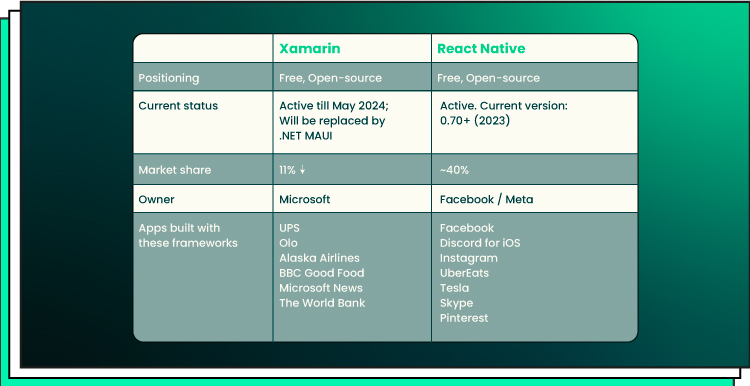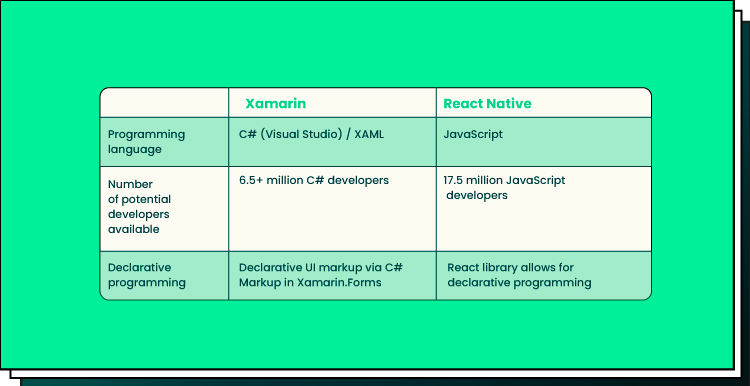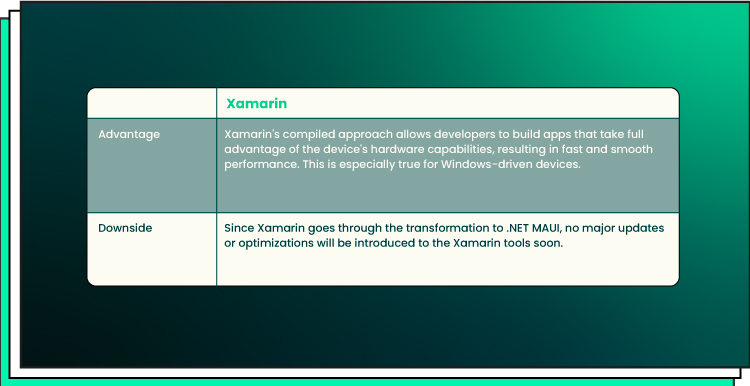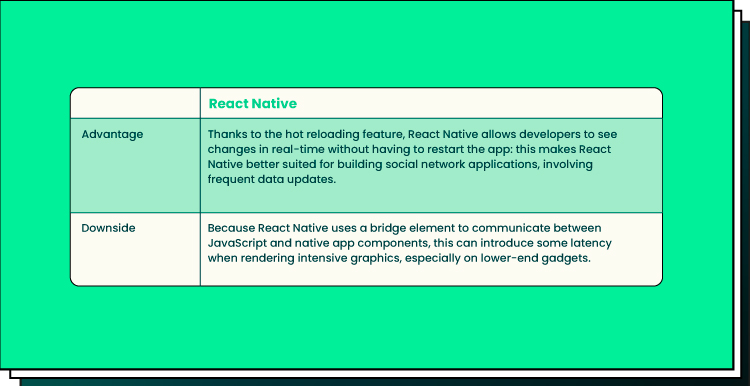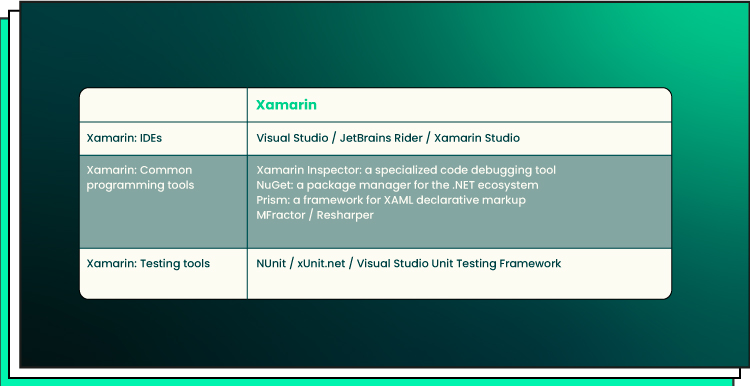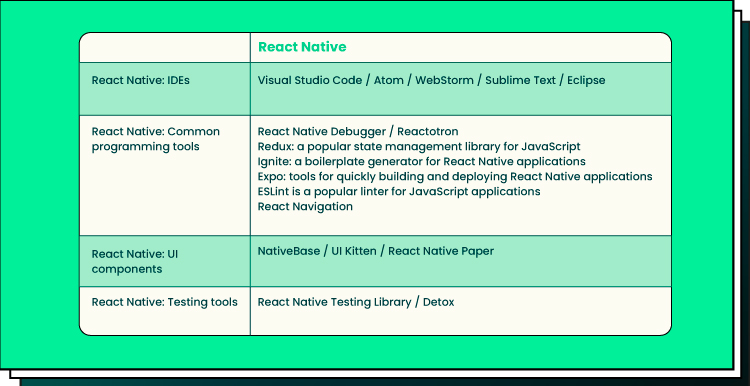In this article, we’ll compare React Native vs. Xamarin to help you choose the best framework for building cross-platform mobile applications (a.k.a. non-native apps.) This software development strategy allows IT specialists to deploy the same product structure and codebase on different platforms, like iOS and Android. The main advantage here is that you can avoid writing two or more app code versions to fit each of the native mobile environments.
Xamarin and React Native both belong to the world’s most popular cross-platform mobile app frameworks. React Native fiercely competes with the Flutter framework for the top position: both options are equally popular with almost 40% of mobile developers. At the same time, Xamarin is currently drawing a moderate level of interest among developers. Its popularity rate gradually decreased from 26% in 2019 to 11% in 2021. You’ll see there is a good reason for this.
Let’s consider Xamarin vs React Native in the context of different criteria, including their prospects, tech capabilities, performance, support, and more. After reading this guide, you’ll be empowered to decide on which of these two frameworks to use for your mobile application development projects.
Cross-Platform Capabilities: React Native vs. Xamarin Frameworks
The main advantage of cross-platform development methodology is the chance to reduce the amount of design and coding required, which makes mobile development projects more cost-efficient and much faster to accomplish.
Both frameworks, Xamarin and React Native, allow you to write your application once and deploy its single codebase on different platforms. This method is opposite to the more expensive and tedious native development approach, which would require two separate developers, or even separate IT teams, to create two different versions of an application for Android and iOS.
Why Do Developers Select Between Xamarin and React Native?
Since both frameworks are non-native development toolboxes, you can avoid learning and utilizing Java + Kotlin (Android) and Objective-C + Swift (iOS) for your projects. You can delve deeper into the pros and cons of native mobile vs. cross-platform development in this article.
Long story short: thanks to the cross-platform framework approach in mobile technologies, developers can maintain the same app functionality, user interface, visual features, and experience across all mobile operating systems with one codebase.
All fixes and updates made in the context of a single codebase can be easily applied to and propagated across multiple application installs, without paying much attention to the specifics of each user device. In the following paragraphs, we’ll consider the capabilities of React vs. Xamarin in the context of cross-platform engineering.
What Are the Main Features of Xamarin?
Xamarin was founded in 2011 as a standalone framework, but later it was bought by Microsoft and integrated with their .NET technology platform. Finally, the MS team has announced that Xamarin is to be replaced by .NET Multi-platform App UI (MAUI) and other products. A complete transition from Xamarin to .NET MAUI is set to be accomplished in May 2024.
Currently, you can freely use Xamarin to write apps for Android, iOS, tvOS, macOS, and Windows. However, it’s recommended that developers move all their Xamarin-written applications to .NET 6-based analogs. Despite the fact that Xamarin seems to be on the way out of the market, all Xamarin projects will keep working after 2024, except for official framework updates and support.
If you require help with transferring your applications from Xamarin to .NET, make sure to contact our .NET engineers for more consulting.
What Are the Main Features of React Native?
React Native is a brainchild of the Facebook (Meta) team, which they launched in 2015. Today, it is a top-notch cross-platform app development framework used in many famous projects, including mobile versions of Facebook and Instagram, and other extremely popular commercial applications.
Unlike Xamarin, React Native is currently at the peak of its popularity and not going to transform or leave the market anytime soon. This mobile app framework works on React, a JavaScript library that supports high-level declarative programming for building user interfaces quickly.
Language and Framework Familiarity: Xamarin or React Native
Xamarin employs a common programming language C# (Visual Studio), which makes this framework easier to learn and master for a large group of C-focused developers. It also features a high code reusability rate: official documentation states that up to 90% of the Xamarin codebase and business logic can be reused across platforms.
This means you can develop Xamarin applications on a PC or Mac device and compile applications into native .apk and .ipa setups, delivering a nearly native-like performance experience for the corresponding mobile operating systems without considerable code revisions. Xamarin.Forms is a framework component that offers declarative UI markup that lets you purely differentiate visuals from UI logic.
React Native incorporates React development capabilities and architecture, like modularity and code reusability, and works on JavaScript. This framework is well-known for the declarative nature of the programming style it offers. Thanks to this method, you can give only high-level directives about the looks and behavior of your mobile product, while the framework automatically covers the rest for you.
With React Native, you can avoid imperative coding with its micromanagement approach, taking too much time to write long and meticulous machine commands. React Native’s modularity allows for ease in breaking down UI functionalities into independent and manageable code blocks.
React vs. Xamarin: Which Developers Are Easier to Find/Hire?
Let’s also compare the global numbers of developers familiar with languages for native and cross-platform development. There are more than 6.5 million C# developers out there; JavaScript has ~17.5 million adepts. At the same time, native mobile programming languages have smaller circles of followers: only about 2.8 million Swift (iOS) and 4.86 million Kotlin (Android) engineers.
This means that native developers can be more expensive and hard to hire. In their turn, React specialists are more numerous than Xamarin experts, which identifies the same trends and conclusions, respectively: React Native developers are the best choice in terms of the price/quality balance.
Performance: React Native & Xamarin Comparison
Both Xamarin and React Native can be used to build a wide range of mobile applications. However, each of these frameworks offers its own specific approach and a set of specifics. Because of that, the spectrum of potential applications that can be created by means of the frameworks may differ in types and industrial preferences. Let’s compare Xamarin and React Native in terms of framework performance and application execution speed.
Xamarin Performance Features: Pros and Cons
When it comes to framework performance, Xamarin and React Native offer different approaches. Xamarin uses the so-called compiled approach, which means compiling C# into native device environment functionality (a productive option for Windows mobile systems.) In this way, the product can leverage all the benefits of accessing the native platform’s APIs and hardware features, like deeper utilization of the GPU and CPU capabilities. It enables higher levels of app performance. In addition to this, Xamarin accelerates app execution with the help of a Just-in-Time (JIT) compiler specific to the .NET technology platform, which can optimize the code at runtime, resulting in faster execution.
Xamarin (.NET) can be a good choice for building complex applications with a lot of native features, such as camera access, sensor data, and location services, especially under the MS system domain. It also works fine for building apps that require a lot of processing power, such as VR, mobile games, e-commerce solutions, or processing-intensive solutions, like educational or scientific tools, AI-based apps, and entertainment applications.
React Native Performance Features: Pros and Cons
React Native uses a hybrid approach that renders the UI using native environment components while using JavaScript to manage the logic of the app. React Native utilizes the so-called “bridge” to communicate between the JavaScript code and the native components (Java on Android, Objective-C on iOS, and C# on Windows), which can impact performance.
Additionally, since React Native does not compile the code into native machine code, it may not be as performant as Xamarin. If a developer feels that this cross-language bridging slows the process down considerably, they can optionally implement the JavaScript functionality in Java, Objective C, or C# with respect to the current system, so the app runs in a purely native way. In this case, a mobile tech engineer writes directly in native code to eliminate the stage of JavaScript-to-native compilation.
React Native performance can be a positive factor for building applications with intense media and visual components in single-page applications, like mobile social networking, real estate mobile applications, and custom e-commerce applications. But it may not be the best choice for cross-platform applications that require high-performance graphics, like mobile games, and VR & AR applications.
Factors that Affect Performance in Both Xamarin and React Native Apps
The performance of these frameworks can be either improved or decreased by manipulating the following factors:
- The size of the application’s codebase.
- The number of third-party libraries connected.
- The quality of the code written (availability of bugs or poor refactoring).
- The device’s hardware capabilities and compatibilities.
- The quality of optimization methods applied.
Overall, both Xamarin and React Native can deliver high-performance mobile apps, but the approach taken by each framework and the specific factors can impact performance. The exact choice depends on the individual app architecture and the requirements of each project. Developers should consider these factors before they opt for one of these frameworks for their mobile cross-platform app development.
If you require help with this, do not hesitate to ask our IT engineers and consultants for immediate help.
Development Tools: React Native or Xamarin?
Let’s have a high-level view of the development ecosystems of both networks. This will help us get a better grasp of their performance and adoption potential in the context of the React vs. Xamarin comparison.
Overview of Xamarin Development Tools
Xamarin offers a rich and hermetic development tech stack with C#, .NET, and Microsoft Visual Studio as an integrated development environment (IDE.) Thanks to this all-around paradigm backed by MS, you can easily access all you need to develop mobile apps with Xamarin. In fact, this makes it one of the most comprehensive cross-platform mobile app development frameworks out there. Since Xamarin is integrated with .NET, its development means can automatically perform memory allocation and garbage collection and achieve the best levels of interoperability with underlying systems.
Xamarin ensures a seamless user experience: the Xamarin.Forms development tool enables C# developers to use standard UI elements with a library of templates and reusable code blocks fully compatible with any platform. When necessary, it’s possible to resort to the help of Xamarin Native libraries including Xamarin.iOS, and Xamarin.Android for more precise manual customization of application functionalities.
These development tools allow for building applications as optimized and prepared for native platforms as possible with a cross-platform framework. Visual Studio and Rider are the most common IDEs employed for Xamarin, while Xamarin.Essentials provides a single API set that operates with any product.
Overview of React Native Development Tools
React Native is part of its own ecosystem, which also involves several tools specific to the JavaScript language and a collective of third-party products integrated into the React Native toolset. React Native includes a light UI-focused framework with a range of pre-built user interface components, such as buttons, text inputs, and scroll views. This feature of React Native allows you to easily customize and combine those components to build complex user interfaces.
One of the key elements unique to React Native is its CLI (Command Line Interface) — the standard command-line interface for creating and managing React Native projects. This tool provides a range of tools for building and deploying React Native applications, such as a bundler, a development server, and tools for generating new components and screens.
It basically facilitates direct access to native modules, which can be an advantage for developers who seek more control over low-level device features or hardware layers. Moreover, it grants additional capabilities for code debugging and development environment customization. React Native has extensive access to countless JavaScript libraries, including those required to manage back-end processes in devices and network data exchange.
Overall, React Native is a very flexible and versatile framework. It is considered easier to learn and more widely used. This helps more people obtain React Native-related knowledge and skills (remember about 17 million JavaScript programmers).
Community and Support: React Native vs. Xamarin
The Xamarin community is very active and consolidated, with a great number of open-source development enthusiasts and contributors from around the world. There exist numerous forums and chats where Xamarin developers can discuss current topics, including the future transition of Xamarin applications to .NET MAUI. The top-quality manuals are supplied by Microsoft themselves, providing extensive support, instructions, and documentation for .NET and Xamarin tools. Till 2024, it’s possible to make use of a dedicated Xamarin support team.
React Native has a large and growing community led by Meta. The community is represented by a wide range of resources, including documentation, tutorials, forums, troubleshooting manuals, and user groups on Discord and other resources. Yet, the overall community of React Native is fragmented because of the abundance of products being a part of the collective React Native plus JavaScript ecosystems. This includes all third-party libraries/plugins and tools, which can feature smaller hardcore communities and even a kind of IT sub-cultures for some of them.
Are You Interested in Building a Cross-platform App?
Xamarin & React Native are both pretty efficient cross-platform mobile development frameworks, but they have some key differences. Mostly, it refers to the selection between C# and JavaScript. Besides that, Xamarin can be a more organic choice for development in Windows-operated environments, as it offers strong integration with the .NET ecosystem and a robust set of development tools. Xamarin performance can sometimes be a concern for native iOS and Android platforms; however, all inefficiencies can be resolved via a variety of .NET tools.
React Native, on the other hand, offers excellent performance for interfaces and a large and active community, but can require more effort and time to sort out all associated middleware and development tools, especially in the back end of your application. Also, its performance can be slower because of the code bridging methods.
If you have an idea for mobile software development or want to switch between frameworks, please contact our hi-tech mobile developers for consulting and help with your project.

Our Engineers
Can Help
Are you ready to discover all benefits of running a business in the digital era?

Our Engineers
Can Help
Are you ready to discover all benefits of running a business in the digital era?
